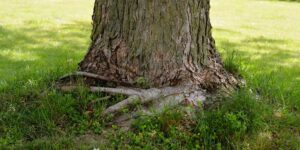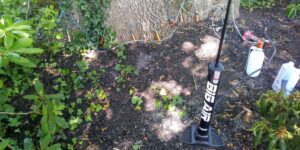If you notice new vertical cracks in your tree trunks or vertical cracks that seem to get wider in the winter, your trees may have frost cracks.
Frost cracks, formed when there are sunny winter days followed by cold winter nights, can be much more noticeable in the winter.
In this article, we’ll go over how to spot frost cracks on your trees, which trees are most susceptible, the health implications for trees that have frost cracks, and more.
How to Spot Frost Cracks
Frost cracks are on the stem (trunk of trees), most often on:
- Young trees
- Trees with thin bark
- Trees that aren’t shaded by anything (often a tree out in the open)
- The south or southwestern sides of trees
Frost cracks are vertical. This split up and down a tree trunk can be small or large – sometimes several feet long. Frost cracks can widen during the winter, exposing more of the inside of the tree, but close up during the summer months.
If you’ve recently heard a loud BANG from your yard or property, it could be a new frost crack forming.
How Do Frost Cracks Form?
When the sun shines directly on a tree trunk during the day and then temperatures plummet at night, the bark contracts, but the inner wood takes longer to shrink. This causes a contraction between the bark and the inner wood, causing an immediate (and loud!) split down the tree.
It doesn’t always have to be at night, either. Any extreme temperature drop or change in the amount of sunlight hitting a tree can cause a frost crack. Sometimes, just the sun moving behind clouds can create the right conditions for a frost crack to form.
After the crack has formed, frost cracks may reopen on any cold winter day but close when the weather warms. A tree may attempt to block the entrance of any predators by growing new wood in the crack, making it more noticeable.
Trees Most Susceptible to Frost Cracks
While any tree can develop a frost crack, these trees are more prone to frost cracks:
- Sycamore trees
- Maple trees
- Apple trees
- Cherry trees
- Horse chestnut trees
- Linden trees
- Walnut trees
- Willow trees
If you have any of these trees, inspect them regularly for frost cracks and prevent winter injury whenever possible.
How to Prevent Frost Cracks in Trees
While not all frost cracks can be prevented, there are some ways you can lessen the chances of your trees splitting due to temperature and sunlight fluctuations.
- Wrap young or vulnerable trees with burlap during the winter months
- Don’t overprune your tree when possible – the shade from the branches can prevent extreme sunlight fluctuations to the trunk
- Keep trees healthy and well-watered
- Add organic mulch around trees
- Fertilize and add compost for your trees when needed
- Treat and prevent any tree health issues or tree pests – stressed or unhealthy trees are often more susceptible
- Be aware of anything that was recently removed around your tree (other trees, shrubs, plants, etc.) that may have previously shaded the tree and protected it from the sun
Some of these steps can also protect your tree against sunscald, another common winter injury to trees.
What to Do if you Spot Frost Cracks on your Trees
If your tree has a tell-tale vertical crack in the stem, what should you do?
The tree will do most of the work, forming a seal and preventing further issues. However, any open wound is attractive to tree pests, and some types of fungus may enter via the crack as well, eventually leading to tree decay.
Some frost cracks reopen each winter, but if reaction wood, a type of new growth, forms around the frost crack, it may be less likely to crack open again.
Don’t try to seal, patch, or fill the frost crack. Trees need to remain flexible to survive, so filling the frost crack with anything will remove the tree’s flexibility. Filling a frost crack hurts rather than helps the tree and can lead to further tree issues.
The best thing you can do is to increase the overall health of the tree through watering, fertilization, proper pruning, plant health care services, and preventative treatments when needed.
Need Help With Your Trees’ Health?
Whether you want to learn how to keep your trees healthy, have questions about issues (such as frost cracks) that you’ve noticed in your landscape, or want to schedule a professional tree service, Alpine Tree can help!
Request an estimate for tree service today.






